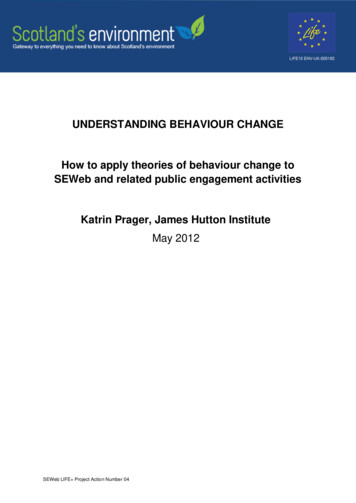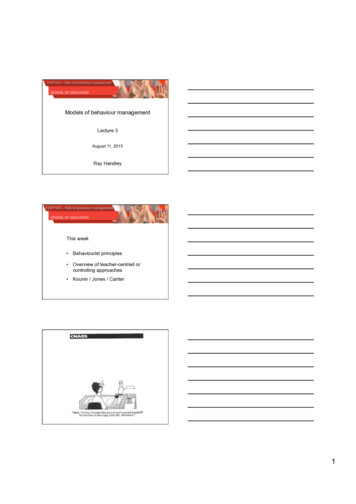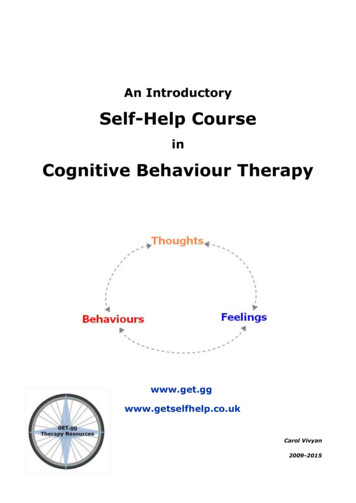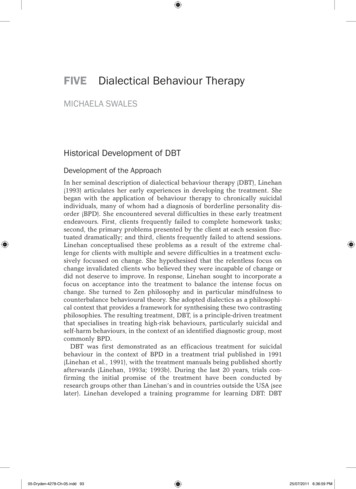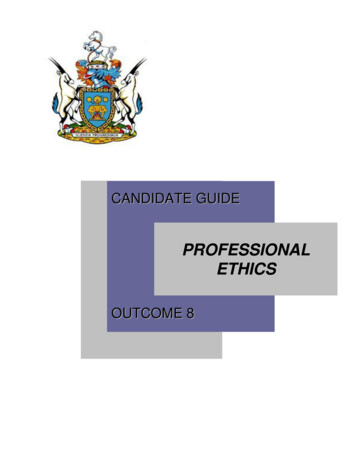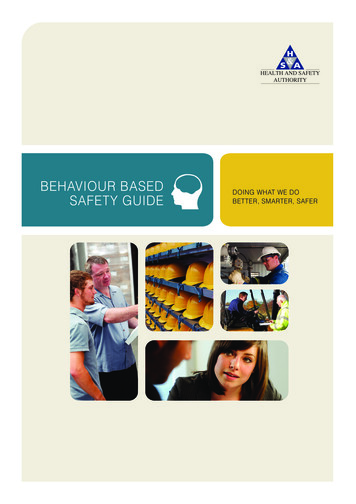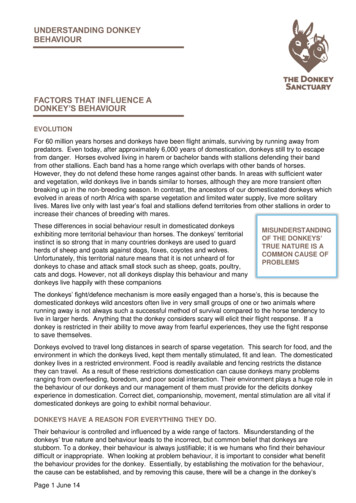
Transcription
UNDERSTANDING DONKEYBEHAVIOURFACTORS THAT INFLUENCE ADONKEY’S BEHAVIOUREVOLUTIONFor 60 million years horses and donkeys have been flight animals, surviving by running away frompredators. Even today, after approximately 6,000 years of domestication, donkeys still try to escapefrom danger. Horses evolved living in harem or bachelor bands with stallions defending their bandfrom other stallions. Each band has a home range which overlaps with other bands of horses.However, they do not defend these home ranges against other bands. In areas with sufficient waterand vegetation, wild donkeys live in bands similar to horses, although they are more transient oftenbreaking up in the non-breeding season. In contrast, the ancestors of our domesticated donkeys whichevolved in areas of north Africa with sparse vegetation and limited water supply, live more solitarylives. Mares live only with last year’s foal and stallions defend territories from other stallions in order toincrease their chances of breeding with mares.These differences in social behaviour result in domesticated donkeysexhibiting more territorial behaviour than horses. The donkeys’ territorialinstinct is so strong that in many countries donkeys are used to guardherds of sheep and goats against dogs, foxes, coyotes and wolves.Unfortunately, this territorial nature means that it is not unheard of fordonkeys to chase and attack small stock such as sheep, goats, poultry,cats and dogs. However, not all donkeys display this behaviour and manydonkeys live happily with these companionsMISUNDERSTANDINGOF THE DONKEYS’TRUE NATURE IS ACOMMON CAUSE OFPROBLEMSThe donkeys’ fight/defence mechanism is more easily engaged than a horse’s, this is because thedomesticated donkeys wild ancestors often live in very small groups of one or two animals whererunning away is not always such a successful method of survival compared to the horse tendency tolive in larger herds. Anything that the donkey considers scary will elicit their flight response. If adonkey is restricted in their ability to move away from fearful experiences, they use the fight responseto save themselves.Donkeys evolved to travel long distances in search of sparse vegetation. This search for food, and theenvironment in which the donkeys lived, kept them mentally stimulated, fit and lean. The domesticateddonkey lives in a restricted environment. Food is readily available and fencing restricts the distancethey can travel. As a result of these restrictions domestication can cause donkeys many problemsranging from overfeeding, boredom, and poor social interaction. Their environment plays a huge role inthe behaviour of our donkeys and our management of them must provide for the deficits donkeyexperience in domestication. Correct diet, companionship, movement, mental stimulation are all vital ifdomesticated donkeys are going to exhibit normal behaviour.DONKEYS HAVE A REASON FOR EVERYTHING THEY DO.Their behaviour is controlled and influenced by a wide range of factors. Misunderstanding of thedonkeys’ true nature and behaviour leads to the incorrect, but common belief that donkeys arestubborn. To a donkey, their behaviour is always justifiable; it is we humans who find their behaviourdifficult or inappropriate. When looking at problem behaviour, it is important to consider what benefitthe behaviour provides for the donkey. Essentially, by establishing the motivation for the behaviour,the cause can be established, and by removing this cause, there will be a change in the donkey’sPage 1 June 14
behaviour. When attempting to establish the causes of behaviour it is important to look at each of theareas contained in this fact-sheet and consider the possible influences of each one, on the donkey’sbehaviour.GENETICSDonkeys have certain behavioural traits which are normal for donkeys and understanding thedifferences in behaviour between horses, donkeys and mules is vitally important before starting anyhandling or training. Donkeys inherit their parents' genes and perhaps the behavioural characteristicsthat go with these genes. It is difficult to know whether behaviours are passed on in the genes or ifcertain behaviour is learnt from parents during the juvenile stage. The behavioural traits of the parentscause their offspring to behave in a similar way.It is important that all mares in foal are well handled to help them develop correct behaviours towardshumans, which will be beneficial to their offspring. Foals should also be consistently handled correctlyas they are growing up.ENVIRONMENTOne of the most important elements provided by theenvironment is mental stimulation Without this stimulation,problem behaviours develop; these behaviours are oftendesigned to relieve the boredom of domestication.Insufficient space increases the competition with herd mates forfood and personal space; this in turn increases stress which canaffect the temperament of the donkey. When interacting with adonkey, owners and handlers become part of the environment;therefore, changes in the behaviour of people can change thebehaviour of donkeys. Any stress that is caused by theenvironment will be reflected in the donkey's behaviour.Any change in the environment or herd dynamics can change the behaviour of a donkey. Changes ofnormal routine can also change the behaviour of donkeys. Wherever possible, environmental changesshould be made slowly and planned carefully to allow the donkey to adjust to changes withoutbecoming stressed. Environmental enrichment is vital for domesticated donkeys.PAINPain is one of the most common causes of behaviour problems in donkeys. If the donkey is in pain, itwill do all it can to relieve this pain. Arthritis, back problems and other injuries can lead to kicking andrefusal to have the feet lifted. If lifting the foot is painful, kicking is anattempt to have the foot placed back on the floor, therefore relieving thepain. Painful tooth growth in young donkeys can increase the incidencesof chewing and nibbling in the environment or of human handlers.Pain should always be considered if a donkey is displaying difficult orabnormal behaviour, and especially in cases of sudden changes ofbehaviour or if the behaviour is out of character with the donkey's normaltemperament, such as where a normally placid donkey becomesaggressive, or starts to kick. In all cases of behavioural problems it isadvisable to consult your veterinary surgeon first to eliminate pain as apossible cause of behaviour change.MEDICAL CONDITIONSThere are numerous medical conditions that may lead to changes in behaviour or the development ofproblem behaviours; these include cystic ovaries, hormonal conditions, mineral and vitaminPage 2
deficiencies, brain tumours, blindness, hearing loss, skin conditions, photo sensitivity and foodintolerances, to name but a few. Often, these conditions are extremely difficult to identify and a vetshould always be consulted to ensure an accurate diagnosis and treatment programme.Female donkeys are likely to come into season every three weeks for four to six days and during thistime it is normal for them to express a range of behaviours including aggressive or difficult behaviouras well as extremely social behaviour. These behaviours are under the influence of normal, hormonalcycles and will vary from mare to mare. It is important to remember that these hormonal cycles maynot happen all year round and in the winter they often don’t occur. Keeping a daily behaviour diary forthree to four months can help identify regular changes in behaviour.PREVIOUS EXPERIENCE/LEARNINGLearning starts from the moment a donkey is born and continues throughouttheir life. Learning can be described as the gaining of knowledge that leadsto relatively permanent changes in behaviour. Whether a foal has beensocialised with other donkeys and allowed to develop correctly through thephases of juvenile development will determine whether the donkey hasbehavioural problems as a mature animal.Situations that induce pain or fear will quickly teach theanimal to fear people involved with such experiences.Every time you interact with your donkey they will learn something. During learning the donkey doesnot consider their behaviour to be good or bad for the human, but only whether the behaviour iseffective for them. Many behaviours that we consider to be problems, are in fact, not a problem for thedonkey and extremely successful in creating a more comfortable or rewarding life for the animal.HUMAN INTERACTIONA donkey’s behaviour will be influenced by the ability, experience and confidence of its handler. Anervous handler will increase the nervousness of the donkey. When a donkey is labelled as "difficult,naughty or bad", the behaviour of the handler changes in accordance with the label and the animal'sbehaviour will reflect how it has been labelled. Donkeys are large, strong animals and it is normal forinexperienced handlers to lack confidence or even be fearful. Anyone intending to handle a donkeyshould gain as much knowledge and experience as possible, prior to commencing any behaviourtraining.TRAININGDonkeys easily learn things that are closest to their naturalbehaviours. Activities, which are completely unnatural to donkeyssuch as being driven, ridden, holding their feet up for the farrier ortravelling in a trailer, can take longer to learn because they are so farremoved from the natural behaviours of the donkey. How donkeysare trained and handled will determine their behaviour. Anexperienced trainer who communicates well with the donkey will helpa donkey to overcome problems and learn more rapidly than adonkey with an impatient or inexperienced handler.Before starting on a training programme or engaging the services of an equinebehaviourist experienced in handling and training donkeys always consult aveterinary surgeon to eliminate any painful or medical conditionsPage 3
The science of behaviour and learning is a very large and complicated subject, and in the case of moredifficult or dangerous behaviours, professional assistance should be sought before commencingtraining. Care should be taken when working with donkeys with behavioural problems. The handlershould be confident with donkeys and take all the necessary precautions to avoid accidents.STEPS TO WORKING WITH BEHAVIOUR PROBLEMSEstablish possible causes of behaviour Have the animal checked by a veterinary surgeon for pain or medical conditionsSeek professional advice if you are unsure of the cause, inexperienced or the behaviour isdangerousLook at your own behaviour to see if that is effecting the donkey’s behaviourStudy and research the behaviour problem, attend a Donkey Sanctuary behaviour courseCreate a shaping or training plan which will break the training it to small achievable stepsCreate a safe environment in which to workAccept retraining can take many months depending on the problem and the trainers abilityTake small steps and do not rushListen to the donkey’s body language; understand that they are communicating with you all the timeDon’t give the donkey negative or derogatory labelsReward good behaviour as a priorityExpect behaviour to get worse before it improvesBEHAVIOUR IS A TERM THAT CAN BE USED TO DESCRIBE EVERYTHING THAT AN ANIMALOR HUMAN DOES. THE SCIENCE OF BEHAVIOUR IS A VAST SUBJECT, MADE MOREDIFFICULT BECAUSE EACH ANIMAL IS AN INDIVIDUAL AND THEREFORE, EVERYBEHAVIOUR IS UNIQUE IN THE WAY IT IS FORMED AND THE WAY THE ANIMAL EXHIBITS IT.IT IS IMPORTANT TO UNDERSTAND THAT A DONKEY WHO IS STANDING STILL AND BEINGSTROKED IS EXHIBITING AS MUCH BEHAVIOUR AS A DONKEY THAT KICKS WHEN THEIRFEET ARE PICKED UP.STUBBORN ASS OR INTELLIGENTDONKEY?The nature of donkeys is not to be aggressive, stubborn or difficult but purely tolearn and survive. Therefore, what is the answer to the question, are donkeysintelligent? They are good at learning to survive and they are good at learning toavoid activities they find difficult, frightening or painful. They have good memoriesand learn very easily. Donkeys are very good at being donkeys.HOW FAST CAN DONKEYS LEARN?Obviously the rate of learning depends on what donkeys aretrying to learn. Donkeys easily learn things that are closest totheir natural behaviours. Activities, which are completelyunnatural to donkeys such as being driven, ridden, holding theirfeet up for the farrier, or travelling in a trailer, can take longer tolearn because they are so far removed from the naturalbehaviours of the donkey. Their rate of learning can certainly beas quick as a dog or a dolphin, both of which are considered tobe extremely intelligent animals. Anyone who owns a donkeywill be aware that they quickly learn that the sound of the doorPage 4
latch to the feed room opening means that food may soon arrive. They learn to control their humansvery quickly, easily training them to scratch their itchy spots, or to deliver food rewards. Often, you willsee donkeys reverse up to their owners because they wish to have their bottoms scratched. Duringthis process of learning, we are seeing a donkey train its owner to scratch the appropriate spot oncommand – pretty clever!Donkeys that have been well handled with positive techniques in the past are more likely to beconfident and more motivated to learn new things through their interaction with humans and theirenvironment. In order to learn most effectively, the lessons need to be offered in small, easilyunderstood sections or steps – this is a process we call ‘shaping behaviour’. All donkeys are individualand their ability to learn is varied. Much relies on the ability of the trainer to be able to communicateaccurately and consistently what is required.WHAT MOTIVATES A DONKEY TO LEARN?Donkeys can be motivated most successfully by things thatthey would naturally find enjoyable such as food or scratches,social interaction with other animals or perhaps being turnedout into a field with their companions. Not all donkeys aremotivated by the same rewards, nor are they motivated to thesame levels. The use of scratches to motivate the animal isreminiscent of two donkeys mutually grooming each other andit has been scientifically shown in horses that grooming the area of thewithers can lower the heart rate of the animal. However, patting a donkey is notreally viewed as a positive experience by the donkey. Donkeys do not pat each other, and thereforefind it difficult to understand what patting means. Patting is very similar to swatting a fly or smackingthe animal, therefore it is always best to scratch the animal as a reward for good behaviour. We maylike to pat our donkeys but scratching is much more appreciated by most donkeys.The donkey can also be motivated to avoid negative stimulus such as a pull on the lead rope ornegative body language. The donkey is motivated to perform the behaviour to stop or avoid somethingit finds negative. This type of motivation should be used carefully with full understanding of theconsequences of misuse. The negative stimulus should not be over used or increased. When it isnecessary to use this type of negative stimulus to motivate the donkey, rewards should also be used toencourage the correct behaviour.CAN YOU TEACH OLD DONKEYS NEW TRICKS?When donkeys are older or if behaviour has been established for many years it is easy to believe thattheir behaviour will not change. However, it certainly is possible to teach old donkeys new behaviours.Once older donkeys are mentally stimulated, by giving them problems to solve and challenges toundertake, they begin to learn new activities more rapidly. Obviously an older animal will have moreestablished behaviour, which is harder to change, so training may take longer.More help and assistance with donkey behaviour problems please ring the welfareadvice line on 01395 578222 or speak to your Donkey Welfare Advisor. Also readthe Donkey Sanctuary fact sheet on Behaviour of Stallions, Geldings and Mares.Page 5
abnormal behaviour, and especially in cases of sudden changes of behaviour or if the behaviour is out of character with the donkey's normal temperament, such as where a normally placid donkey becomes aggressive, or starts to kick. In all cases of behavioural problems it is advisable to con


